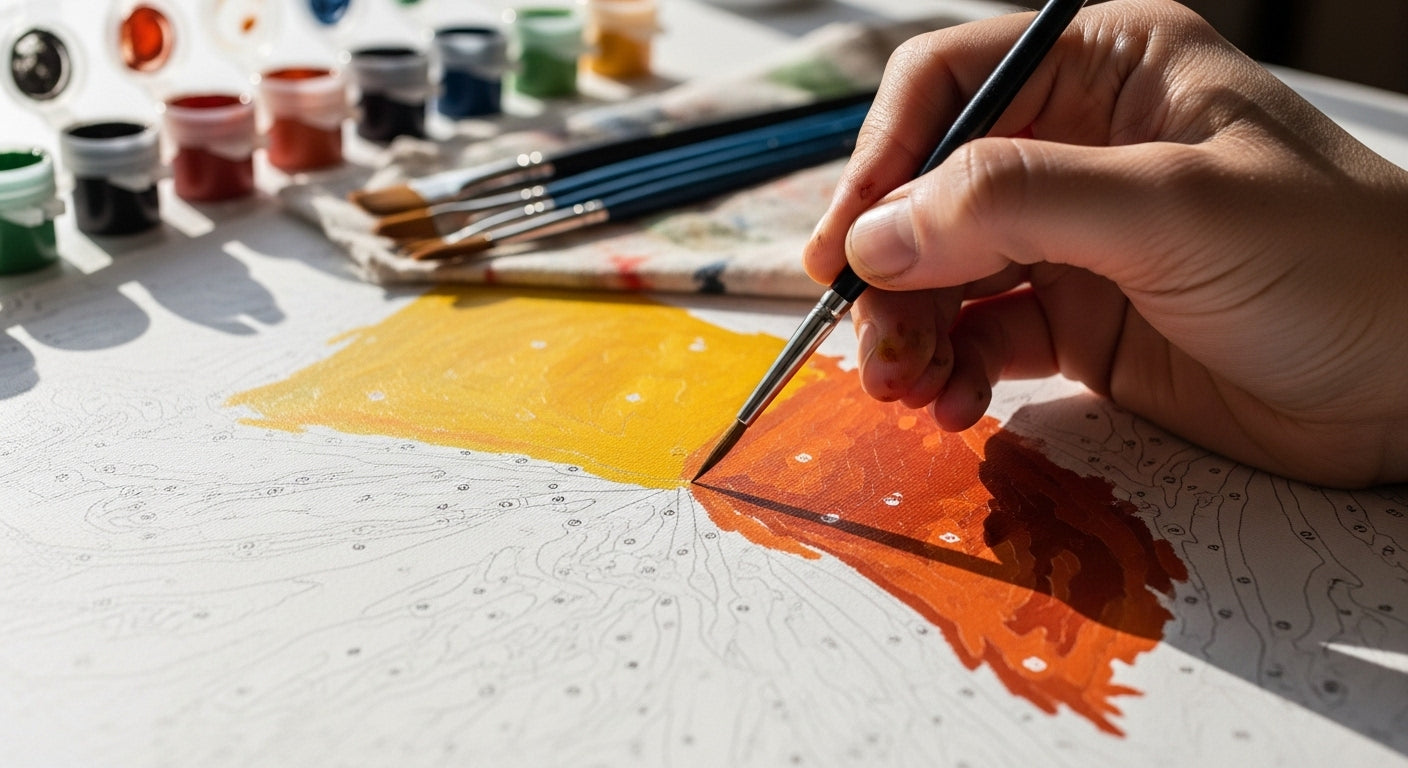Paint by numbers offers art enthusiasts an accessible and enjoyable way to create stunning works of art, regardless of their experience level. One of the most powerful skills you can develop to take your paint by numbers projects to new heights is mastering the art of blending techniques. Blending allows you to produce smooth color transitions, add depth and texture, and give your paintings a more refined and professional look.

In this blog post, we will unravel the mystery behind blending techniques in paint by numbers. We'll start by exploring the basics of dry brush and wet brush approaches before diving into the world of wet-on-wet blending techniques, which enable seamless transitions and captivating results. Lastly, we'll discuss tips and tricks for successful blending that you can apply to your paint by numbers projects, helping you create artwork that stands out and impresses.
Crafty By Numbers is passionate about helping individuals explore their creativity and find relaxation through our high-quality paint by numbers kits. By learning to master blending techniques, you'll unlock new ways to elevate your paint by numbers projects, creating captivating and dynamic art pieces that reflect your unique style.
Whether you're a hobbyist, beginner, art enthusiast, stress-reliever, or decorator, this blog post aims to inform, inspire, and equip you with the essential tools and techniques required for successful blending in your paint by numbers projects. So, let's embark on this artistic journey and discover the power of blending techniques to breathe new life into your paint by numbers artwork.
Understanding the Basics: Dry Brush vs. Wet Brush Blending
Before delving into specific blending techniques, it's essential to understand the basic approaches: dry brush and wet brush blending. These methods determine how you apply paint to your canvas and how you manipulate it to create various effects.
- Dry Brush Blending: This technique involves using a relatively dry brush with little or no water or paint thinner. The paint is applied with light strokes, and as the brush dries, the colors blend more smoothly. This method is ideal for adding texture and depth to your paint by numbers projects.
- Wet Brush Blending: In contrast, wet brush blending uses a brush saturated with water or paint thinner, resulting in a more fluid application. This technique allows for smoother color transitions and a softer look in your artwork.
Understanding these two approaches will lay the foundation for exploring more advanced blending techniques in your paint by numbers projects.
Mastering Wet-on-Wet Blending Techniques for Seamless Transitions
Wet-on-wet blending, also known as "alla prima," is a technique in which wet paint is applied directly on top of wet paint. This method creates smooth, seamless color transitions and is popular in oil and watercolor painting. To incorporate wet-on-wet blending in your paint by numbers projects, follow these steps:
- Apply the first color to the canvas, using a wet brush to ensure the paint remains wet longer. Remember that paint dries faster in warmer temperatures and under direct light, so adjust your environment accordingly.
- Clean your brush or use a separate brush, and apply the second color directly adjacent to the first color while both paints are still wet.
- Use light, gentle brush strokes to blend the two colors together, creating a smooth transition between them.
Wet-on-wet blending takes practice but can add a professional touch to your paint by numbers artwork.
Exploring Dry Brush Blending for Texture and Depth
Dry brush blending is an effective technique for adding texture and depth to your paint by numbers projects. With less water or paint thinner, the paint dries more quickly, allowing for seamless blending and greater control over color transitions. To practice dry brush blending, follow these guidelines:

- Apply a base color to your canvas, allowing it to dry completely.
- Dip your brush into the second color, and then remove any excess paint on a paper towel or palette. This step ensures that your brush is mostly dry, with just a small amount of paint remaining.
- Using light pressure, stroke your brush over the dried base color in the desired direction. The paint should catch on the textured surface of the canvas, creating a blended look.
- Experiment with varying amounts of pressure and brush angles to achieve unique textures and depth within your work.
Dry brush blending is an effective way to create stunning effects in your paint by numbers projects, imbuing them with depth and character.
Tips and Tricks for Successful Blending in Your Paint by Numbers Projects
- Clean your brushes regularly to maintain control over color transitions.
- Use a palette or a non-porous surface to preload your brush with two colors before applying them to the canvas.
- Experiment with different brush sizes and shapes to discover the best tools for your desired blending effects.
- Practice patience and give yourself time to develop your blending skills; mastery comes with experience and persistence.
Elevate Your Paint-by-Numbers Artwork with Blending Techniques
By understanding the basics of dry brush and wet brush blending and mastering more advanced techniques like wet-on-wet blending, you can significantly enhance your paint-by-numbers projects. Professional-looking artwork is within reach when you invest time in practicing and perfecting your blending skills.
Allow yourself the freedom to experiment, learn, and grow as an artist, and watch your customized paint by numbers projects transform into stunning, captivating masterpieces that showcase your unique style and skill. With blending techniques in your artistic toolbox, the possibilities for your paint by numbers artwork are boundless. Happy painting!













